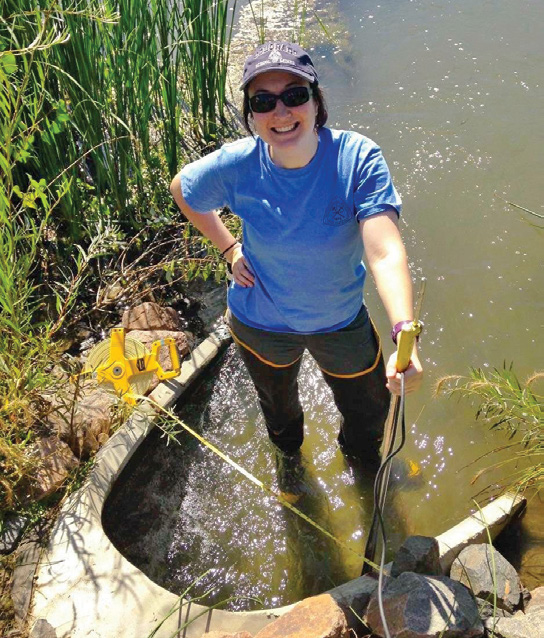“This is it,” PhD student Chelsea Panos ’15 says when talking about how much she loves hydrology. “I didn’t discover hydrology until my senior year when I took hydrology lab, and then I was like, this is really it. Environmental engineering is cool, but this is where it is.”
Panos began her journey at Mines as an undergraduate student in the physics department before discovering her true passion: environmental engineering, and more specifically—hydrology. This passion earned her an Outstanding Graduating Senior Award at the end of her undergraduate career. “It was awesome to be recognized for all of the hard work I had put into four and a half years here,” she says. “That reception was definitely a highlight of graduation.”
But her journey at Mines didn’t end there; Panos immediately returned to pursue a PhD in the Hydrologic Science and Engineering (HSE) program, one of the top hydrology programs in the United States. Through this program, Panos was given the opportunity of a lifetime when the City and County of Denver approached Mines with a project related to stormwater modeling in the Berkeley neighborhood. Although she had previously participated in stormwater research in Los Angeles, when offered the chance to work in her own backyard, there was no way Panos could pass it up. “That’s the dream, to do what you love doing but in a place that’s home,” she says.
Denver’s Berkeley project looks at how infill development, or reurbanization, impacts stormwater quality and quantity. The research focuses on the development of a stormwater-modeling tool for implementing Best Management Practices (BMPs) in re-urbanized areas using the EPA’s System for Urban Stormwater Treatment and Analysis IntegratioN (SUSTAIN) model. “One of the unique challenges we’re facing in Denver that we didn’t see in Los Angeles is a lack of data availability, so right now we’re collecting data within the basin,” Panos explains. “We’re installing our own sensors within the storm sewer network in the Berkeley neighborhood.”
 Panos regularly goes out into the field to stream gauge and download the data to use in her model. “Sometimes I feel like a storm chaser, because when it rains, I get to go out there and collect my own data,” she says. “I know exactly where that data came from, I analyze it, and I then put it into my model.”
Panos regularly goes out into the field to stream gauge and download the data to use in her model. “Sometimes I feel like a storm chaser, because when it rains, I get to go out there and collect my own data,” she says. “I know exactly where that data came from, I analyze it, and I then put it into my model.”
Her research is particularly important to Denver now, as the city continues to attract new residents. “The population of Denver is expected to increase by over 100,000 people in the next 10 years, so that’s really going to change how water is used,” Panos says. Stormwater could be a valuable resource to help offset some of this significant urban growth.
Panos also sees a need for similar research all across the West. “We were never supposed to build giant cities in the middle of deserts like Los Angeles, and people are realizing the potential for harnessing stormwater to help out these water-stressed areas and to increase water security,” she says. “Stormwater is this cool, untapped resource right now, and there’s so much research popping up to look into how we can use stormwater and treat it to increase both water quantity and quality.”
In recognition of her efforts on the Denver stormwater project, Panos recently received a National Science Foundation (NSF) Graduate Research Fellowship. The NSF program supports graduate students in STEM fields across the U.S., and Panos received one of 2,000 award offers selected from about 17,000 applications. She plans to use this award to help further her professional development and research goals.
Panos hopes to continue urban hydrology research in the future and share her knowledge with others. She says, “A lot of unique challenges arise from being in an urban area, and just the whole idea of bringing a part of nature back into the city is really cool.”







